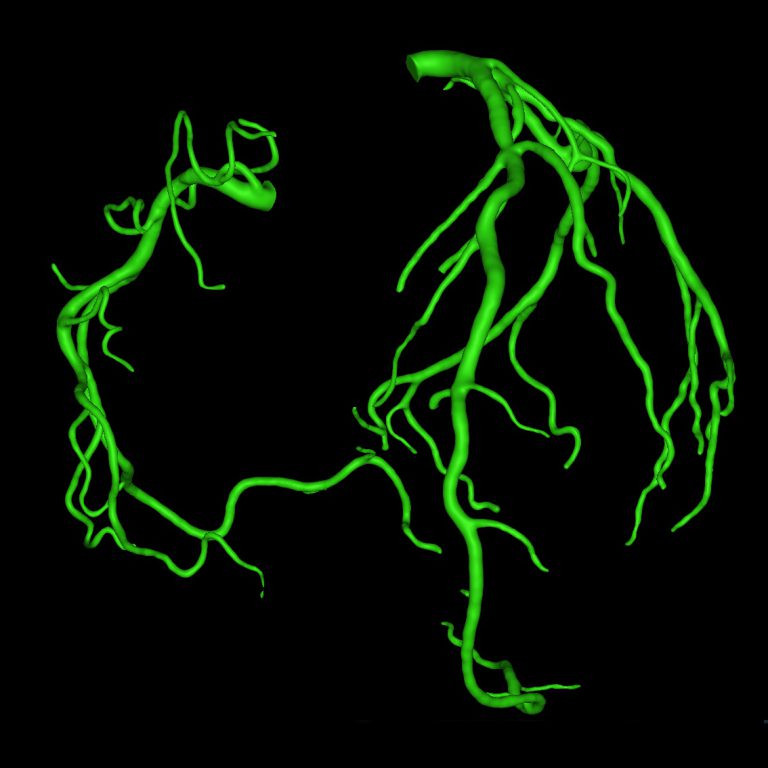Medical image segmentation as a method for the preparation of learning data
Medical image segmentation is seemingly a simple process. Undoubtedly, many factors contribute to achieving high-quality results, especially including proper preparation of medical input data for medical image segmentation segmentation.
In the first place, in this post – as announced in the previous article – we will focus on the preparation of input data, i.e. medical image data for medical image processing.
Moreover, we will look at the medical image segmentation process and our methodology and give some tips on how to improve this process.
Medical image segmentation and algorithm training and verification
Preparing the data of the learning set and the test set for machine learning in medical image segmentation is usually a time-consuming and costly process but at the same time necessary to obtain the desired results.
No doubt, large sets of diverse data are needed to train and verify the performance of an artificial intelligence algorithm.
Not only the quality of the data but also quality of the segmentations themselves are crucial here. Therefore, it is on this input information that the results obtained depend.

The segmentation process can result in a much more detailed view of the coronary arteries than standard volume rendering. In the picture: coronary arteries – the result of Graylight Imaging MedTeam’s work.
Imaging data anonymization for medical image segmentation
Imaging data acquired for software development should provide complete anonymity to patients. Not only personal data but also health information is considered as sensitive data to be protected.
The use of patient data while maintaining patient privacy is possible by applying anonymization or pseudo-anonymization techniques. These allow data to be encoded according to a special, unique key that has no connection to a specific person.
We delete all data that could identify the patient and require anonymization by applicable laws during the anonymization process.
For image data, it is also crucial to encode pixel data if it illustrates recognizable visual features of the patient that would enable identification – such as facial features.
Imaging data – secure storage
Medical software development – including AI medical software – continues to evolve, contributing to new advancements.
This eliminates the risk of leaking sensitive data and allows you to place the resulting models in the right location.
Remember that the acquired data must be properly stored to facilitate verification database communication and archiving. And also, to safely use them to evaluate the potential of artificial intelligence [Data preparation for artificial intelligence in medical imaging: A comprehensive guide to open-access platforms and tools – ScienceDirect].
Medical image segmentation – differentiation of imaging data
The acquisition of high-quality medical imaging data is part of the AI medical software development process. But in addition to quality, its diversity is also crucial.
It is important to provide as diverse data as possible in the learning set selection development process. It is worth ensuring that the data comes from devices of different manufacturers, but also from different medical centers.
In our case, adding segmentations from multiple authors positively influenced the segmentation results. Such measures allow to improve the results of the neural network. Such measures allow to improve the results of the neural network.
The diversity of medical imaging data helps to improve the reliability of the network. It makes the network less sensitive to image artifacts or anatomical anomalies.
Providing quality data is worthwhile
Preparing image data sets, performing input segmentation, and developing network architecture and parameters are labor-intensive processes.
The driving force here is the prospect that the effort put in and the activities performed will create solutions leading to the acquisition of objective data that can provide important diagnostic information.
Preparing high quality input data for segmentation, allows to achieve very accurate results of the medical image segmentation process. The video shows contouring of the coronary arteries.
In medical image segmentation and in medicine AI is one of the major trends
To sum up, as mentioned in Data preparation for artificial intelligence in medical imaging: A comprehensive guide to open-access platforms and tools – ScienceDirect: A comprehensive guide to open-access platforms and tools, many researchers and developers are focusing on the development of methods, tools, platforms, and standards to facilitate the process of providing high-quality medical imaging data, as well as the activities of developing artificial intelligence methods.
Thus, AI is one of the key trends in modern medicine and medical image analysis, although only a few AI-based products are currently certified for medical applications. Will this be enough to gain the trust of the medical world? In brief, the answer to this question will likely come soon.
To conclude, according to a report by the Deloitte Center for Health Solutions in 2019, the models of MedTech companies will undergo significant changes within the next 20 years. This change will require closer collaboration between organizations to meet the ever-growing healthcare needs of patients, which are becoming increasingly complex.
Contact us if you have any questions!